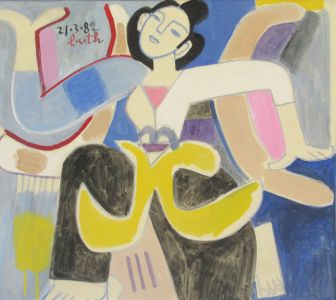ARTIST LE CONG THANH
Born in 1931 in Da Nang, Viet Nam
Graduated from the Fine Art College To Ngoc Van (Session during Resistance, War 1955 - 1957) and Hanoi Fine Arts University
Teaching at Hanoi Industry Designer University 1963
Work as a free sculptor 1975
His works collected in Vietnam Fine Arts Museum
Many private collections in Vietnam, France, Italy, US, Holland, Switzerland, Hong Kong, Singapore and Korea
Exhibitions :
Solo exhibition in Hanoi 1970
Group exhibition in Paris , France 1997 and 2004
Solo exhibition in Hanoi 2017
Awards : The Vietnam State Award and the First Class Labor Order 2001
Born in Da Nang in 1931, Le Cong Thanh grew up and worked in the north. Graduated from Hanoi Fine Art Institute in 1962 and was a teacher at the Hanoi Fine Art University from 1962 to 1968. Had close working relations with Tu Nghiem, Bui Xuan Phai and Nguyen Sang. Studied art in Russia from 1968 to 1970. Had many solo and group exhibitions around the world. In 2001 he won two prestigious Award, the Vietnam State Award and the First Class Labor Order.
Le Cong Thanh and the question of the human condition
Le Cong Thanh was part of the emeritus of South Vietnam. A graduate of the Hanoi Art School in 1962 and having studied abroad, this young sculptor artist represented, without doubt, hope for the new revolutionary sculpture movement. From his very first exhibits in the early 1970s and despite his young age, Le Cong Thanh was deemed an icon and treated like an elder of the village. Indeed Le Cong Thanh realized very early on how to seize and appropriate himself all that everyone was aspiring to under the banner of “ nationalism and modernism”, alongside Nguyen Hai, a more sentimental and popular artist whereas he was more rational, erudite and “occidental”. The Path towards a new stage of sculpture was hence paved, richer and more characteristic than the incongruous, academic, grossly realistic sculpture quickly made at the Fine Arts College of Vietnam under the French influence. Le Cong Thanh enriched his works in a gentle and accurate manner with the echoes of modern international sculpture, unfamiliar to the public and more or less banned in Vietnam in those days. He created volumes oscillating between closures and opening, links, virtual topological spaces, games in volumes and forms, the invisible and the visible…..It seems to him that the confrontation, the contradiction between East and West is but a conventional artifice belonging to the dogmatic researcher. There are no exaggerated differences between the East and the West, because man has been the same since the dawn of time, regardless of the place. Otherwise, how would we be able to coexist Le Cong Thanh tried for a brief period to express him-self through projects dealing with public monuments going in two directions. On one hand, he adopted a modern approach towards the beauty of forms, as in the case of “Statue pour place publique”, made from new materials and a new technique called socialist realism, in concrete. On the other hand, he adopted an illustrative style like in the case of Nyi Thanh, which he created for his homeland. He quickly abandoned this work, which he thought could never reproduce the beauty of the place ( in the cultural and concrete context of that time). He transformed himself into a alchemist, lock up in a mysterious theosophical space, he usual way of discovering the pure gold of volumes from the sand and dust of the world. We are left with the impression that he sculpts with the veneration and natural abilities of the artist of the high plains creating symbols of life and death, of this earthly existence and that of the heavens through sculpting a mere piece of wood. More precisely, Le Cong Thanh is a mystical and a genius ( of Champa) faithfully sculpting a complete temple with female and male bodies in a trance, jubilant, in pain, torn between two beams of light: that of the flesh and that of philosophy. He has sculpted, chiseled, contemplated, closed his eyes and meditated while murmuring, chanting incomprehensible words like magical invocation, but also like the monologue of a character in a tragedy. It is not sure not language which express it, but rather these experiments and this meditation, the use of creativity as a means of this experiment and this meditation on the human condition, very rare in our art which tending less and less to reflect reality, that has permitted to create a personal space for his art. To kid him, Le Cong Thanh’s friends call him the Vietnamese Henry Moore, which is partly true, for two reasons: he has received a lot from the outside world, but it has opened the door to our culture. I would nevertheless like to say that solely the question that he addresses to the human condition can allow the work to reach the heart of the esthetic quality of every fruit of the tree of life
By Nguyen Quan
(Ho Chi Minh City, October, 2003)

















